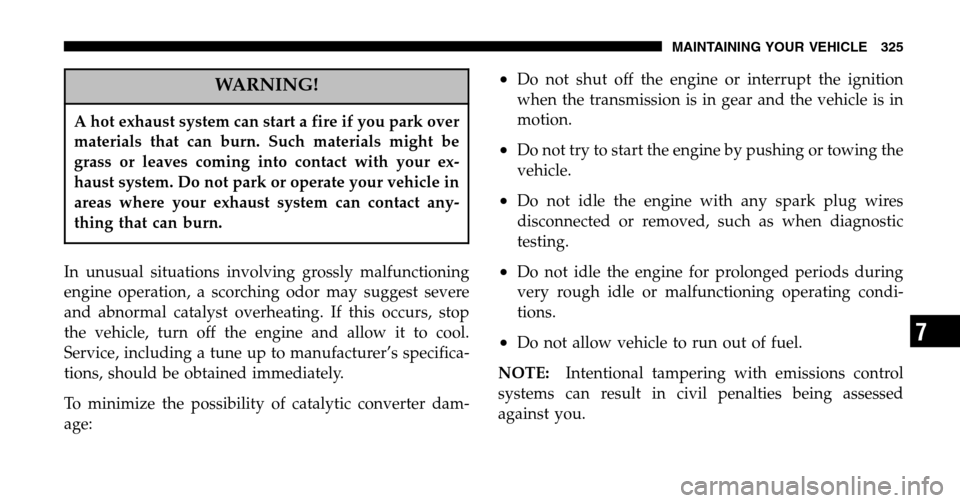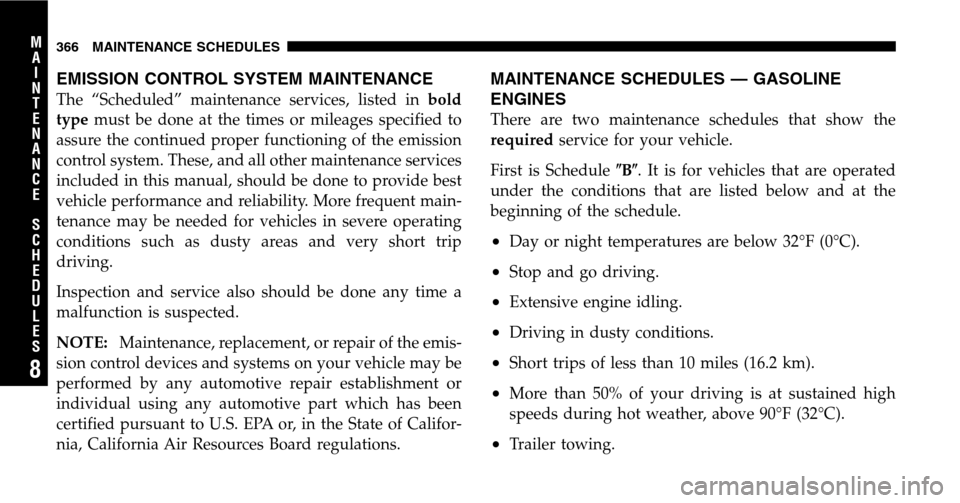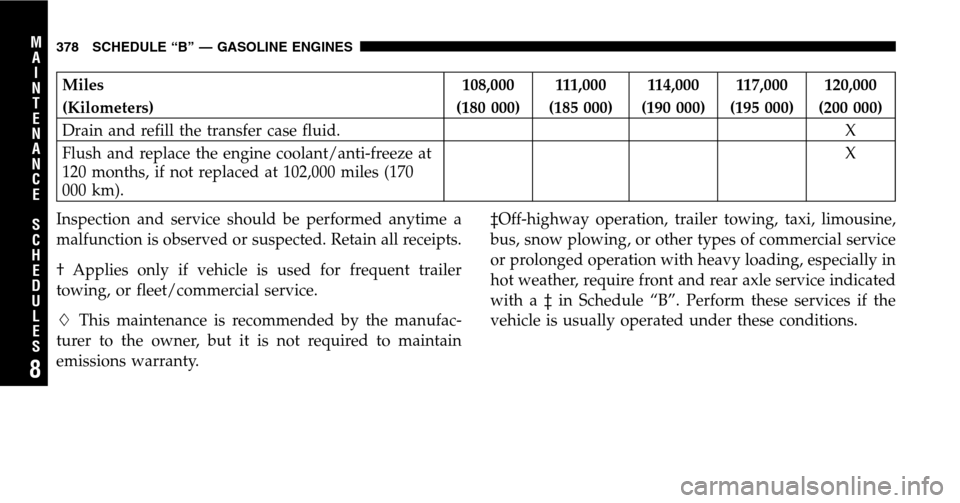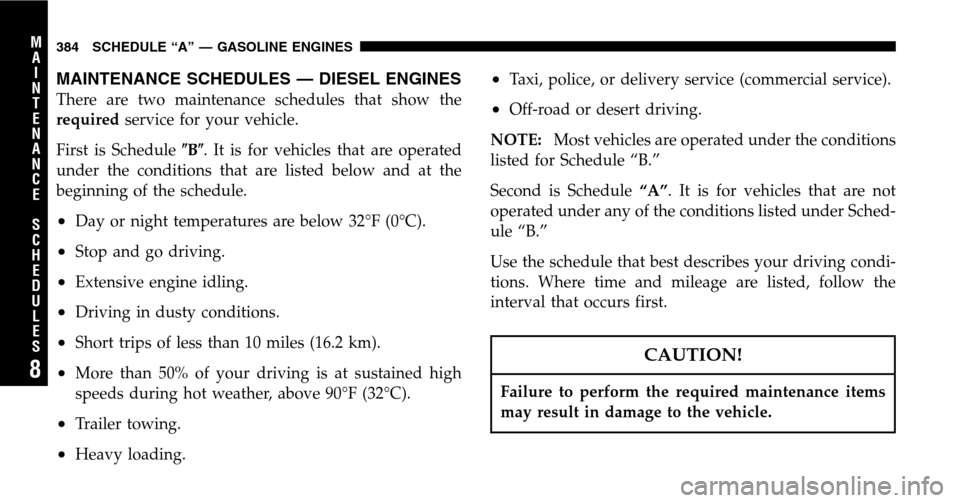Page 320 of 424

The best time to check the engine oil level is about 5
minutes after a fully warmed engine has been shut off, or
before starting the engine after it has sat overnight.
Checking the oil while the vehicle is on level ground will
improve the accuracy of the oil level readings. Maintain
the oil level between the ADD and SAFE markings on the
dipstick. Adding 1 U.S. Quart (0.95L) of oil when the
reading is at the ADD mark will result in a SAFE reading
on these engines.
CAUTION!
Overfilling or underfilling the crankcase will cause
aeration or loss of oil pressure. This could damage
your engine.
Change Engine Oil
Road conditions as well as your kind of driving affect the
interval at which your oil should be changed. Check the
following to determine if any apply to you:
•Day or night temperatures are below 32°F (0°C)
•Stop and go driving
•Extensive engine idling
•Driving in dusty conditions
•Short trip driving of less than 10 miles (16.2 km)
•More than 50% of your driving is at sustained high
speeds during hot weather, above 90°F (32°C)
•Taxi, Police, or delivery service (commercial service)
•Trailer towing
•Off-road or desert driving
320 MAINTAINING YOUR VEHICLE
Page 325 of 424

WARNING!
A hot exhaust system can start a fire if you park over
materials that can burn. Such materials might be
grass or leaves coming into contact with your ex-
haust system. Do not park or operate your vehicle in
areas where your exhaust system can contact any-
thing that can burn.
In unusual situations involving grossly malfunctioning
engine operation, a scorching odor may suggest severe
and abnormal catalyst overheating. If this occurs, stop
the vehicle, turn off the engine and allow it to cool.
Service, including a tune up to manufacturer’s specifica-
tions, should be obtained immediately.
To minimize the possibility of catalytic converter dam-
age:
•Do not shut off the engine or interrupt the ignition
when the transmission is in gear and the vehicle is in
motion.
•Do not try to start the engine by pushing or towing the
vehicle.
•Do not idle the engine with any spark plug wires
disconnected or removed, such as when diagnostic
testing.
•Do not idle the engine for prolonged periods during
very rough idle or malfunctioning operating condi-
tions.
•Do not allow vehicle to run out of fuel.
NOTE: Intentional tampering with emissions control
systems can result in civil penalties being assessed
against you.
MAINTAINING YOUR VEHICLE 325
7
Page 363 of 424

FLUIDS, LUBRICANTS, AND GENUINE PARTS
Engine
Component Fluid, Lubricant, or Genuine Part
Engine Coolant Mopar �Antifreeze/Coolant 5 Year/100,000 Mile Formula HOAT (Hybrid Organic Ad-
ditive Technology)
Engine Oil (3.7L Engines) Use API Certified SAE 5W-30 Engine Oil, meeting the requirements of DaimlerChrysler Material Standard MS-6395.
Engine Oil (2.8L Diesel En-
gines) Use SAE 0W-40 Synthetic Engine Oil that meets API Categories SM/CF, and the re-
quirements of DaimlerChrysler Material Standard MS-10725. If SAE 0W-40 is not avail-
able, SAE 5W-40 Synthetic Engine Oil is acceptable.
Oil Filter (3.7L Engine) Mopar �Oil Filter (P/N 4781452AA or 4781452BB)
Oil Filter (2.8L Diesel Engine) Mopar �Oil Filter (P/N 5003558AA)
Spark Plugs Refer to the Vehicle Emission Control Information label in the engine compartment.
Fuel Selection (Gasoline En-
gines Only) 87 Octane (89 Octane should be used for trailer towing purposes - 3.7L Only).
Fuel Selection (Diesel Engines
Only) Use good quality diesel fuel from a reputable supplier. For most year-round service,
No. 2 diesel fuel meeting ASTM specification D-975 will provide good performance.
This vehicle is fully compatible with biodiesel blends up to 5% biodiesel meeting
ASTM specification D-975.
MAINTAINING YOUR VEHICLE 363
7
Page 364 of 424
Chassis
Component Fluid, Lubricant, or Genuine Part
Automatic Transmission Mopar �ATF+4 Automatic Transmission Fluid
Manual Transmission Mopar �Manual Transmission Lubricant or equivalent (meeting the re-
quirements of DaimlerChrysler Material Standard MS-9224)
Transfer Case Mopar �ATF+4 Automatic Transmission Fluid
Axle Differential (Front) Mopar �Gear & Axle Lubricant (SAE 80W-90) or equivalent.
Axle Differential (Rear) Mopar �Synthetic Gear Lubricant (SAE 75W-90) or equivalent. For trailer
towing, the lubricant should be replaced with Mopar �Synthetic Gear &
Axle Lubricant (SAE 75W-140) or equivalent. Models equipped with Trac-
Lok™ require a limited-slip additive.
Brake Master Cylinder Mopar �DOT 3 Brake Fluid, SAE J1703 should be used. If DOT 3, SAE
J1703 brake fluid is not available, then DOT 4 is acceptable. Use only rec-
ommended brake fluids.
Power Steering Reservoir Mopar �ATF+4 Automatic Transmission Fluid
364 MAINTAINING YOUR VEHICLE
Page 366 of 424

EMISSION CONTROL SYSTEM MAINTENANCE
The “Scheduled” maintenance services, listed inbold
type must be done at the times or mileages specified to
assure the continued proper functioning of the emission
control system. These, and all other maintenance services
included in this manual, should be done to provide best
vehicle performance and reliability. More frequent main-
tenance may be needed for vehicles in severe operating
conditions such as dusty areas and very short trip
driving.
Inspection and service also should be done any time a
malfunction is suspected.
NOTE: Maintenance, replacement, or repair of the emis-
sion control devices and systems on your vehicle may be
performed by any automotive repair establishment or
individual using any automotive part which has been
certified pursuant to U.S. EPA or, in the State of Califor-
nia, California Air Resources Board regulations.
MAINTENANCE SCHEDULES — GASOLINE
ENGINES
There are two maintenance schedules that show the
required service for your vehicle.
First is Schedule �B�. It is for vehicles that are operated
under the conditions that are listed below and at the
beginning of the schedule.
•Day or night temperatures are below 32°F (0°C).
•Stop and go driving.
•Extensive engine idling.
•Driving in dusty conditions.
•Short trips of less than 10 miles (16.2 km).
•More than 50% of your driving is at sustained high
speeds during hot weather, above 90°F (32°C).
•Trailer towing.
366 MAINTENANCE SCHEDULES
8
M A I
N T
E
N A
N C E
S
C
H E
D
U L
E
S
Page 369 of 424

Schedule “B” — Gasoline Engines
Follow schedule “B” if you usually operate your vehicle
under one or more of the following conditions.
•Day or night temperatures are below 32°F (0°C).
•Stop and go driving.
•Extensive engine idling.
•Driving in dusty conditions.
•Short trips of less than 10 miles (16.2 km).
•More than 50% of your driving is at sustained high
speeds during hot weather, above 90°F (32°C).
•Trailer towing.
•Heavy loading.
•Taxi, police, or delivery service (commercial service).
•Off-road or desert driving.
•If equipped for and operated with E-85 (ethanol) fuel.
NOTE: IfANY of these apply to you then change your
engine oil every 3,000 miles (5 000 km) or 3 months,
whichever comes first and follow “Schedule B” of the
“Maintenance Schedules” section of this manual.
NOTE: IfANY of these apply to you then flush and
replace your engine coolant/anti-freeze every 102,000
miles (170 000 km) or 60 months, whichever comes first,
and follow “Schedule B” of the “Maintenance Schedules”
section of this manual.
SCHEDULE “B” — GASOLINE ENGINES 369
8
M A I
N T
E
N A
N C E
S
C
H E
D
U L
E
S
Page 378 of 424

Miles 108,000 111,000 114,000 117,000 120,000
(Kilometers) (180 000) (185 000) (190 000) (195 000) (200 000)
Drain and refill the transfer case fluid. X
Flush and replace the engine coolant/anti-freeze at
120 months, if not replaced at 102,000 miles (170
000 km). X
Inspection and service should be performed anytime a
malfunction is observed or suspected. Retain all receipts.
† Applies only if vehicle is used for frequent trailer
towing, or fleet/commercial service.
This maintenance is recommended by the manufac-
turer to the owner, but it is not required to maintain
emissions warranty. ‡Off-highway operation, trailer towing, taxi, limousine,
bus, snow plowing, or other types of commercial service
or prolonged operation with heavy loading, especially in
hot weather, require front and rear axle service indicated
witha‡in Schedule “B”. Perform these services if the
vehicle is usually operated under these conditions.
378 SCHEDULE “B” — GASOLINE ENGINES
8
M
A I
N T
E
N A
N C E
S
C
H E
D
U L
E
S
Page 384 of 424

MAINTENANCE SCHEDULES — DIESEL ENGINES
There are two maintenance schedules that show the
required service for your vehicle.
First is Schedule �B�. It is for vehicles that are operated
under the conditions that are listed below and at the
beginning of the schedule.
•Day or night temperatures are below 32°F (0°C).
•Stop and go driving.
•Extensive engine idling.
•Driving in dusty conditions.
•Short trips of less than 10 miles (16.2 km).
•More than 50% of your driving is at sustained high
speeds during hot weather, above 90°F (32°C).
•Trailer towing.
•Heavy loading.
•Taxi, police, or delivery service (commercial service).
•Off-road or desert driving.
NOTE: Most vehicles are operated under the conditions
listed for Schedule “B.”
Second is Schedule “A”. It is for vehicles that are not
operated under any of the conditions listed under Sched-
ule “B.”
Use the schedule that best describes your driving condi-
tions. Where time and mileage are listed, follow the
interval that occurs first.
CAUTION!
Failure to perform the required maintenance items
may result in damage to the vehicle.
384 SCHEDULE “A” — GASOLINE ENGINES
8
M A I
N T
E
N A
N C E
S
C
H E
D
U L
E
S